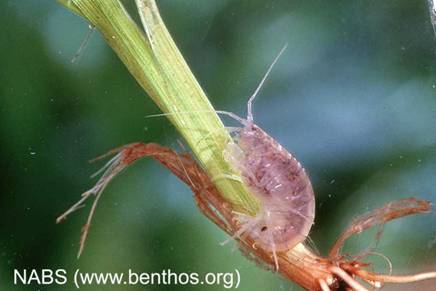Home → Water Quality → M Monitoring & Reporting → Biomonitoring → Sampling & Analysis → Macroinvertebrate Types → Scuds
 Scuds (Amphipoda)
Scuds (Amphipoda)
Scuds are members of a bottom dwelling class of crustaceans called Malacostraca. This class also includes aquatic sow bugs (Isopoda), crayfish, and shrimps (Decapoda). Although most scuds live in the ocean, over 100 species are found in freshwater.
Scuds range from 5-20mm long. They are most easy to recognize by their comma-like body shape, which is strongly flattened from side to side. Scuds have 2 pairs of antennae and 7 pairs of legs. Like all crustaceans, they have an exoskeleton made of both calcium carbonate (a major material in snail and mussel shells) and chitin (the same material found in human fingernails). Crustaceans reproduce sexually. Newly hatched juveniles look essentially like small adults. Crustaceans grow larger throughout their entire lives, shedding their hard exoskeleton when it is outgrown and generating a new one.
Scuds are omnivores that most commonly eat detritus, although they may also graze on live algae, fungi, and bacteria. They will occasionally attack small living animals, and will eat any recently dead plants and animals they come upon. Scuds live in many habitats of all different sizes, but are most common in the shallows of cool streams, springs, seeps, lakes, and ponds, as well as the backwaters of large rivers. They are usually associated with loose substrate.
As a group scuds can be found in a wide range of pollution levels. Because scuds breathe by absorbing dissolved oxygen through their gills, they can't live in severely polluted or stagnant waters that contain no oxygen close to the sediment. Some species are also highly sensitive to heavy metal and pesticide pollution.
Picture key
Photo: A scud (Crangonyx sp.)
Source: The North American Benthological Society
Bibliography
Voshell, Jr., J. Reese; illustrated by Amy Bartlett Wright. 2002. A Guide to Common Freshwater Invertebrates of North America. Blacksburg (VA): The McDonald & Woodward Publishing Company. 442 p